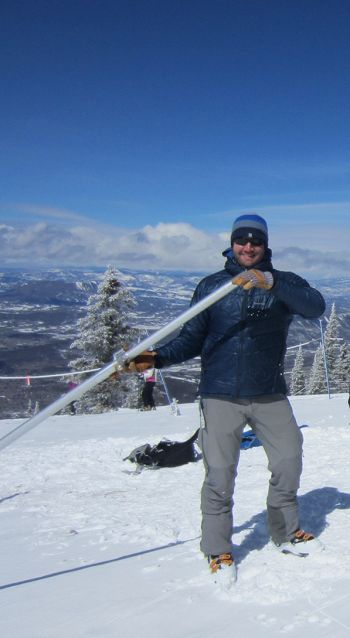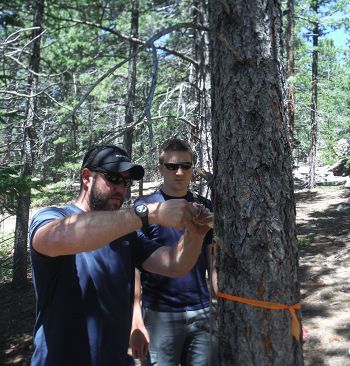Critical Zone Profile - DAVE BARNARD (tree eco-physiologist, postdoctoral fellow)
Under forest cover, many of the sun’s rays are intercepted by the tree canopy above, altering the rate at which snow melts when compared with open areas. The light intercepted by the canopy is then either re-radiated in all directions as heat or is used to evaporate water in the leaves, cooling the canopy and providing the driving force for transpiration – processes necessary to transport nutrients from the soil to the leaves.
Dave Barnard’s research focuses on the interactions between the energy that is absorbed by the canopy and used to fuel biological processes (i.e., transpiration and photosynthesis) and that which is re-radiated as heat or that penetrates the canopy as direct-beam energy and is absorbed by the snow pack - influencing snow melt rates. To investigate questions regarding these forest-snow-atmosphere interactions, Barnard studies different components of the overall system, including: the response of individual leaves to changes in solar radiation, how snow pack accumulation and melt varies among different forest structures, how transpiration responds to changes in solar radiation and temperature, and how the energy balance of entire forests can vary over the course of the snow accumulation and melt periods.
“So many important processes are compressed into a relatively thin layer at the surface of the planet.” – Dave Barnard
I grew up in northern Florida but spent much of my free time traveling through and visiting the mountains of the West. After finishing my bachelor’s degree at the University of Florida, I headed west, working for the Forest Service in Idaho before beginning a master’s degree program in Forest Ecology at Oregon State University. After finishing my master’s degree, I completed a PhD at Colorado State University in tree physiology and micrometeorology. During this time I developed a deep and passionate interest in mountain snow dynamics and how they impact ecosystem functioning.
Once I finished my PhD, I was fortunate to be accepted as the Boulder Creek CZO postdoctoral fellow, allowing me to focus my research on my interests in vegetation-snow interactions in alpine and montane forests.
The sun provides the overwhelming majority of energy available at the planet’s surface to fuel biological activity and to drive numerous components of the hydrologic cycle. Sunlight is needed to power photosynthesis in plant leaves, which converts atmospheric carbon dioxide into oxygen for animals to breathe. Sunlight is also absorbed by the air, soil, rocks, and vegetation, warming them and providing comfortable temperatures for plants to grow and animals to carry on their life cycles. As the sun gets higher in the sky in spring, total incoming solar radiation increases, serving as the primary energy source for melting the snow pack that has accumulated over the winter and providing the majority of freshwater resources to both ecological and human systems.
Interestingly, the rate at which snow melts determines how much and when water is available for the forest to use. In the winter-spring-summer transition period, forests tend to be less active physiologically, but they still play an important role in determining the snow pack energy balance. The bulk of my work at the Boulder Creek CZO is focused on this transition period, through questions addressing how active trees are physiologically during this period in terms of transpiration, what signals dominate in determining physiological activity, and what influence transpiration has during this transition period on forest carbon uptake and snow pack energy balance and snow melt rates. To answer these questions, I use observations at scales ranging from an individual leaf, to the whole tree, to remotely sensed metrics of landscape-scale responses.
Dave (left) shows Kevin Thirouin (right) how sap flow sensors are wired and connected to trees to measure sap flow (a proxy for canopy transpiration) on a pine tree in upper Gordon Gulch at the Boulder CZO. Photo courtesy of Joey Gamora.
As an early career scientist I have greatly appreciated the numerous travel grant opportunities afforded me through the CZO network, both domestically and internationally. In the future I hope to engage in cross-CZO studies, collaborate with other PIs and post-docs, and utilize the large volume of data available from CZO sites. The CZO network provides broad-scale measurement and interpretation of critical landscape processes in archived and real-time format.
I am currently involved in mentoring Kevin Thirouin, a student at Red Rocks Community College in Golden, Colorado. When Thirouin started working with me, he was not really aware of the importance of the critical zone in large-scale processes. He has enjoyed his exposure to CZO operations and to some of the methods we use to address scientific questions.
Since beginning my fellowship with the CZO in the winter of 2015, I have come to fully grasp the problems that limited freshwater supplies will cause on both an ecological and human-civilization level. Ecological issues can sometimes be difficult to “monetize.” Educating the public increases awareness and builds context for understanding these important issues
:: By Linda Copman, staff writer ::
Dave Barnard
Dave (left) shows Kevin Thirouin (right) how sap flow sensors are wired and connected to trees to measure sap flow (a proxy for canopy transpiration) on a pine tree in upper Gordon Gulch at the Boulder CZO. Photo courtesy of Joey Gamora.
Related News
Explore Further








